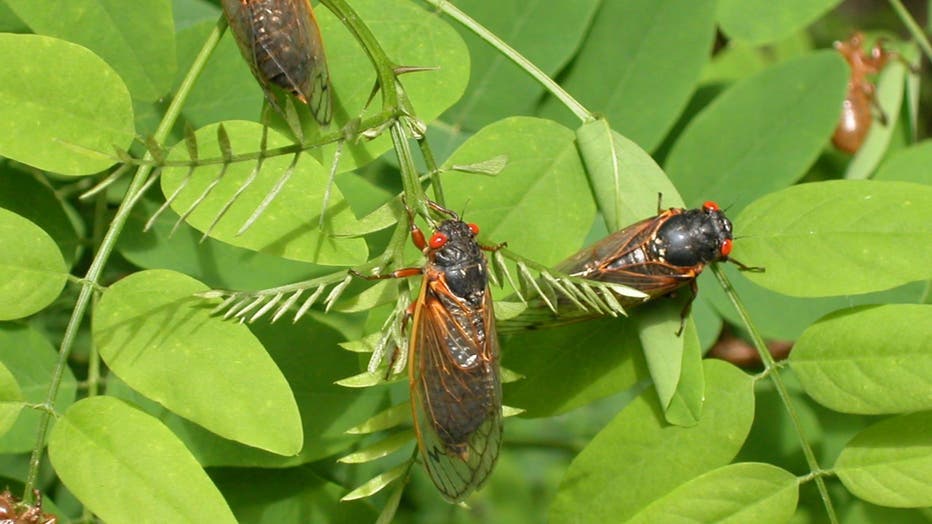Don't eat cicadas if you are allergic to shrimp, shellfish, FDA warns

A newly emerged adult cicada from brood X suns itself on a leaf May 16, 2004 in Reston, Virginia - file photo. (Photo by Richard Ellis/Getty Images)
NEW YORK - The Food and Drug Administration has a colorful warning for people with a shellfish allergy: don’t eat cicadas. Turns out, the agency warns, that the noisy insects actually share a "family relation" to shrimp and lobsters.
"Yep! We have to say it!" the FDA tweeted on Wednesday. "Don’t eat #cicadas if you’re allergic to seafood as these insects share a family relation to shrimp and lobsters."
While the warning surprised many of the FDA’s Twitter followers, it turns out eating cicadas isn’t unheard of, and it’s not even the first time experts have issued the warning for those with shellfish allergies. In fact, last month Montclair State University released a how-to on harvesting and cooking cicadas.
"Brood X cicadas are one of the world’s most incredible animal phenomena," Cortni Borgerson, assistant a university assistant professor of anthropology, said in the explainer. "In a year where few of us may be traveling to see natural wonders like Africa’s great migration, or the elephant gathering of Sri Lanka, we are incredibly privileged to have this rare spectacle occurring in our very own backyards. Brood X provides an infusion of nutrients into the ecosystem, and humans have been enjoying this event for its sights, sounds and taste for millennia."
While maybe not the case for you, Borgerson pointed out that insects are considered an important source of food for as many as 2 billion people. Tracking down Brood X cicadas, however, can be tricky so Borgerson offered a few tips.
"You’ll be able to hear when you’re close," Borgerson said. "These cicadas live as nymphs underground for 17 years, and then tunnel up through the ground to the surface where they shed into their winged adult phase, living only 4-6 weeks. Cicada are tastiest in their teneral stage, which is right after they’ve shed into their adult forms, but are still pale while before their exoskeletons have hardened."

(Richard Ellis/Getty Images)
Their texture is described as similar to shrimp or crustaceans, but they don't need to be peeled before consumption or after being cooked. There are even some restaurants that serve them inside tacos. One chef told USA Today that there’s never been a complaint about the dish following an order.
"I’ve seen every plate that comes back with them, and they’ve all been empty," Tobias Padovano, a chef at a Virginia restaurant told USA Today. "People are incredibly excited about them. They come in and they ask for them."
So why the warning for those with a shellfish allergy?
"A shellfish allergy increases the likelihood that you will be allergic to cicada, so it’s better to be safe than sorry and abstain from land arthropods if you can’t eat their sea swimming cousins," Borgerson said.
FREE DOWNLOAD: Get breaking news alerts in the FOX6 News app for iOS or Android.
Crustacean shellfish are considered to be one of the eight most common allergenic foods which make up 90% of food allergic reactions in the U.S., according to the FDA.
Symptoms of a food allergy may present as hives, flushed skin or rash, tingling or itchy sensation in the mouth, face, tongue or lip swelling, vomiting or diarrhea, abdominal cramps, coughing or wheezing, dizziness or lightheadedness, swelling of the throat and vocal cords, difficulty breathing, and even loss of consciousness. They can also be life-threatening and even cause anaphylaxis.

Free beer from Anheuser-Busch if America hits COVID vaccine goal
Anheuser-Busch is offering to buy Americans a beer if 70% of the population gets the COVID vaccine by July 4.

